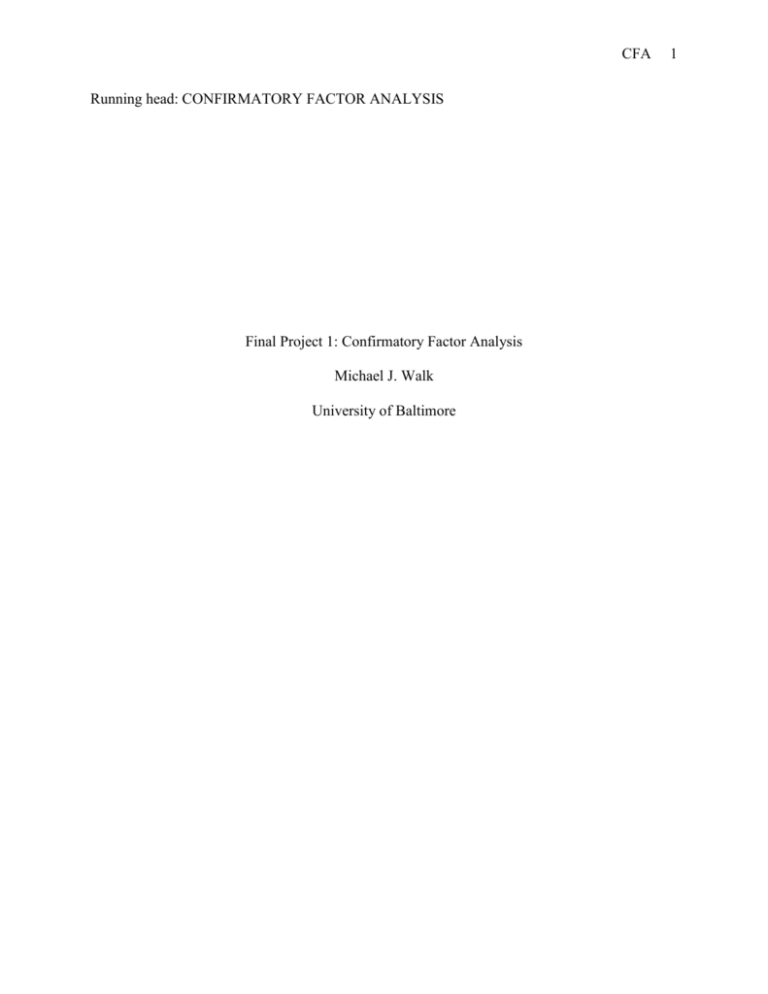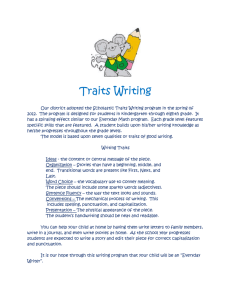Project 1 - jwalkonline.org
advertisement

CFA Running head: CONFIRMATORY FACTOR ANALYSIS Final Project 1: Confirmatory Factor Analysis Michael J. Walk University of Baltimore 1 CFA Final Project 1: Confirmatory Factor Analysis PRELIS Syntax !PRELIS SYNTAX: Can be edited SY='E:\Class\Multivariate\Homework\Project 1\project1.PSF' OU MA=KM SM=corr.dat SD=sd.dat XT XM Correlation Matrix var12 -------- var13 -------- var21 -------- var22 -------- var23 -------- var11 var12 var13 var21 var22 var23 var31 var32 var33 var11 -------1.000 0.298 0.314 0.172 0.138 0.053 0.347 0.197 0.229 1.000 0.408 0.279 0.376 0.284 0.083 0.160 0.273 1.000 0.148 0.127 0.221 0.283 0.212 0.368 1.000 0.316 0.244 0.430 0.131 0.278 1.000 0.206 0.153 0.173 0.077 1.000 0.205 0.101 0.255 var32 -------- var33 -------- var31 var32 var33 var31 -------1.000 0.201 0.331 1.000 0.241 1.000 var21 -------1.833 var22 -------1.904 var23 -------2.120 Standard Deviations Standard Deviations var11 -------2.199 var12 -------1.890 var13 -------2.028 var32 -------1.868 var33 -------1.943 Standard Deviations var31 -------1.959 Comparison of SPSS and PRELIS Outputs SPSS and PRELIS were used to calculate the standard deviations and correlations for var11-33. The outputs from each program were identical. The outputs from SPSS and PRELIS are included in Appendix A1 and A2, respectively. 2 CFA 3 Model Testing The following research examined the validity of three traits: problem solving (PS), interpersonal skill (IS), and initiative (IN). Data were collected from 300 cases by using three methods: group discussion (GD), competitive task (TK), and role-play (RP). There were nine observed variables: var11, var12, var13, var21, var22, var23, var31, var32, and var33. Confirmatory factor analyses were performed using LISREL to estimate all measurement models. Model 1 The first analysis was performed using the three hypothesized traits as factors; the three methods were not included in the model. The tested model is presented as Figure 1. LISREL output is included in Appendix B. Model 1 did not adequately fit the data, 2(24, N = 300) = 107.75, p < .01, RMSEA = .11, GFI = .93, and AGFI = .86, suggesting that the three traits were not the only latent variables influencing the nine observed variables. Model 2 A second model was tested that included six factors, the three traits as well as the three methods. Correlations between traits and methods were fixed to zero. The tested model is presented as Figure 2. LISREL output is included in Appendix C. Support was found for Model 2, χ2(12, N = 300) = 25.46, p < .05, RMSEA = .06, GFI = .98, and AGFI = .93. However, there were three problems in the model’s path coefficients. (The following reported model coefficients are completely standardized.) The factor loading for var31 on role-play was negative (-.11), while all other variable loadings were positive. The coefficient between role-play and competitive task was negative (-.02), while all other coefficients between CFA 4 latent variables were positive. In addition, var12 had a negative error variance (-2.23), while all other error variances were positive. Model 2-2 In order to improve upon Model 2, the analysis was performed with the error variance of var12 constrained to equal the error variance of var32, which was a conceptually similar variable since both were indicators of interpersonal skill. LISREL output is included in Appendix D. The model fit was not substantially altered, χ2(13, N = 300) = 26.27, p < .05, RMSEA = .06, GFI = .98, AGFI = .93. The completely standardized solution of Model 2-2 was examined to determine if constraining the error variance of var12 to equal the error variance of var32 fixed the problems present in Model 2. The negative factor loading of var31 on role-play was improved; the value became 0.0. The negative path coefficient between role-play and competitive task was no longer negative; however the value was extremely large: 36.97. The error variance of var12 was not improved; both var12 and var32 had a negative error variance (.40 and -.41, respectively). Model 3 In order to improve upon Model 2-2, the analysis was performed again; the error variance of var12 was constrained to equal the error variance of var31, which had the smallest error variance in Model 1. LISREL output is included in Appendix E. The model fit remained relatively the same, χ2(13, N = 300) = 26.68, p < .05, RMSEA = .06, GFI = .98, AGFI = .93. The completely standardized solution of Model 3 was examined to determine if constraining the error variance of var12 to equal the error variance of var31 improved upon the previously identified problems. No improvement was found. The negative factor loading was still present (-.66), the negative coefficient between role-play and competitive CFA 5 task was still present (-.04), and the negative error variance, although reduced, was still present (var12 = -.22 and var31 = -.20). Model 4 The consistent problems found in Models 2, 2-2, and 3 suggested that role-play was not a valid measure of var31, so a new model was designed without the path between role-play and var31. In this model, Model 4, the path between role-play and var31 was fixed to zero, and the error variance of var12 was constrained to equal the error variance of var31.The model is illustrated in Figure 3. The LISREL matrix language necessary to estimate the proposed paths in the model is included below the figure and individual commands for each lambda-X are presented on the corresponding model path. LISREL output is included in Appendix F. The hypothesized model demonstrated sufficient fit, χ2(14, N = 300) = 31.05, p < .01, RMSEA = .06, CFI = .97, GFI = .98, AGFI = .93. Also, examination of the completely standardized solution revealed no problems in the model coefficients. All problematically negative values were now positive. Model 4 fit the data well (according to standardized fit indices). All factor loadings were significant except for the loading of var12 on IS (B = .18, SE = .20, t = .91, ns), indicating that var12 was not a good measure of interpersonal skill. However, the need to include methods in the model in order to produce adequate model fit suggests that the variables measured in this study included not only trait effects but also method effects. Model 5 In order to examine the discriminate validity of the three traits, a confirmatory factor analaysis was run with the correlations between the three traits fixed to 1.00. LISREL output is included in Appendix G. CFA 6 The results indicated mediocre model fit, χ2(17, N = 300) = 49.69, p < .01, RMSEA = .08, GFI = .96, AGFI = .91 A pseudo chi-square test was used to determine if there was a significant difference between Model 4 (in which coefficients between traits were estimated) and Model 5 (in which coefficients between traits were fixed to 1.00). The difference in degress of freedom between Model 5 and Model 4 was 17 – 14 = 3. The difference in chi-square was 49.69 – 31.05 = 18.64. The critical chi-square for df = 3, α = .05, was 7.82. The psuedo chi-square exceed the critical value; therefore, Model 4 fit the data significantly better than Model 5, supporting the hypothesis that the three traits (problem solving, interpersonal skill, and initiative) are different constructs. Conclusion Several models were examined through confirmatory factor analyses. There were nine observed variables and six latent variables—three traits (problem solving, interpersonal skill, and initiative) and three methods (group discussion, competitive task, and role-play). Indices of fit for all five models are presented in Table 1. The traits only model (Model 1) lacked adquate data fit. The traits and methods model (Model 2) was found to adequately fit the data; however, there were problems in several of the model coefficients (i.e., three of them were negative). Several attempts were made to fix the problematic coefficients (Models 2-2, 3, and 4), with only Model 4 having both adequate fit and no problematic coefficients. Model 4 was tested against Model 5 (in which inter-trait correlations were fixed to 1.00) to demonstrate evidence of discriminant validity for the three traits. Model 4 fit the data significantly better than Model 5, providing evidence of trait validity. However, Model 4 did not fit the data better than Model 1, suggesting that the traits, as well as the methods used, influenced participants’ scores on the nine observed variables. CFA Table 1 Exercises (Methods) and Traits: Indices of Fit df 2 RMSEA GFI AGFI Model 1 (traits only) 24 107.75 .11 .93 .86 Model 2 (traits and methods) 12 25.46 .06 .98 .93 Model 3 (with rogue value) 13 26.68 .06 .98 .93 Model 4 (delete rogue LX) 14 31.05 .06 .98 .93 Model 5 (traits fixed to 1) 17 49.69 .08 .96 .91 Model 7 CFA Figure 1. Model 1: Nine observed variables influenced by three traits. var11 PS var12 var13 var21 IS var22 var23 var31 IN var32 var33 Figure 2. Model 2: nine observed variables influenced by three traits and three methods. var11 GD var12 PS var13 var21 TK var22 IS var23 var31 RP var32 var33 IN 8 CFA Figure 3. Model 4: Nine observed variables influenced by six latent variables. The LISREL matrix language associated with each proposed lambda-X is included in the model. var11 GD var12 PS var13 var21 TK var22 IS var23 var31 IN RP var32 var33 To free lambda-X’s: FR LX(1,1) LX(4,1) LX(7,1) LX(2,2) LX(5,2) LX(8,2) LX(3,3) LX(6,3) LX(9,3) LX(1,4) LX(2,4) LX(3,4) LX(4,5) LX(5,5) LX(6,5) LX(8,6) LX(9,6) To fix lambda-X of RP and var31: FI LX(7,6) 9









